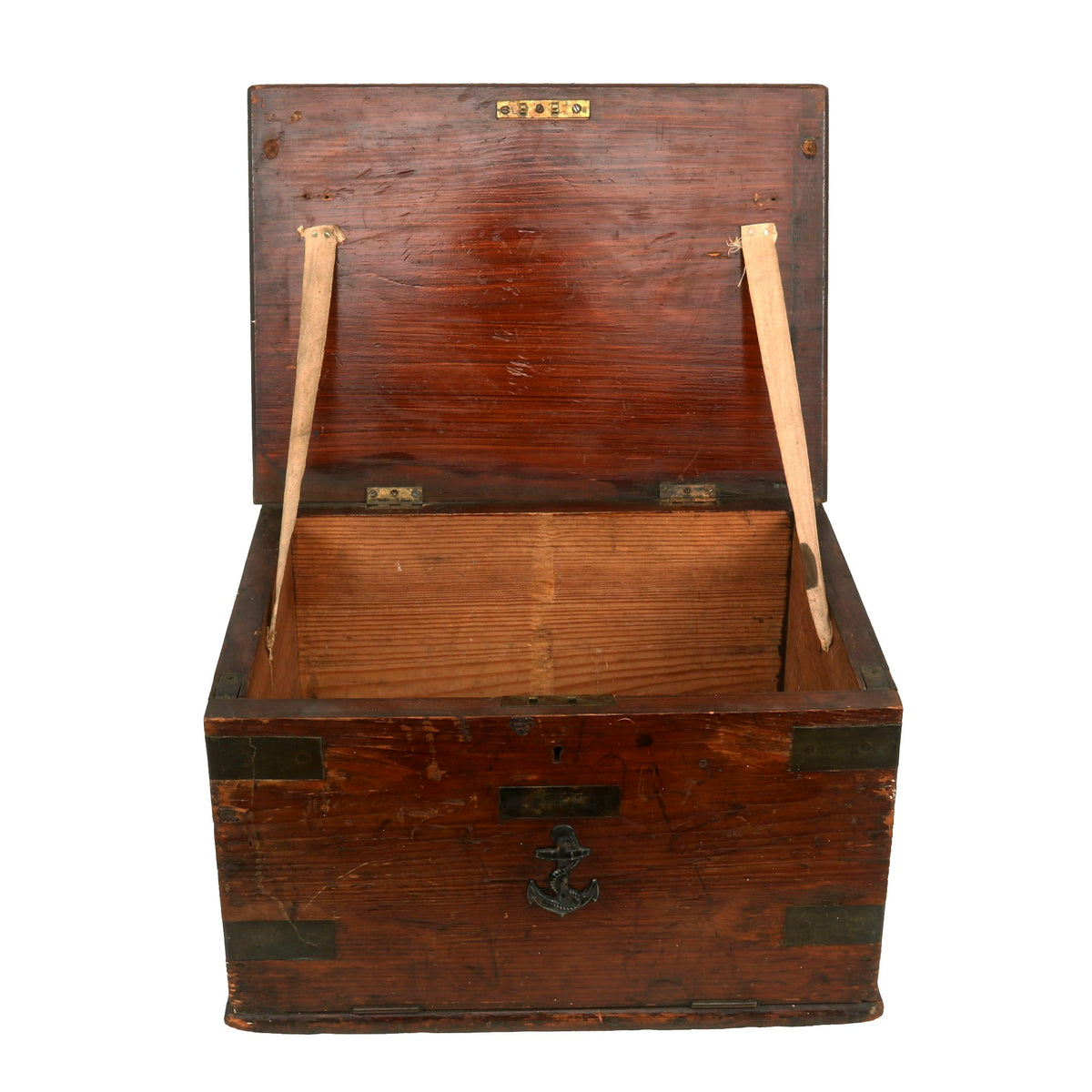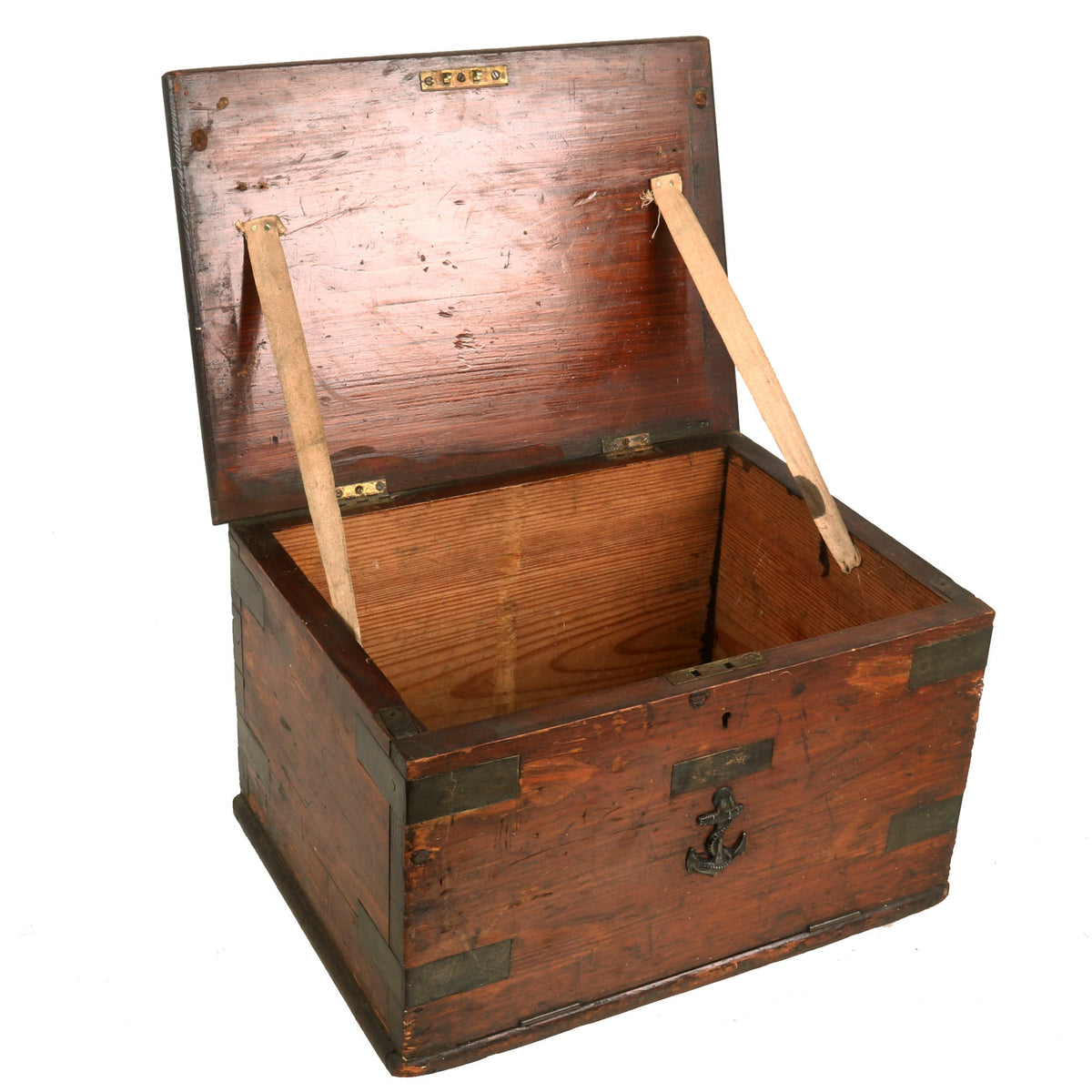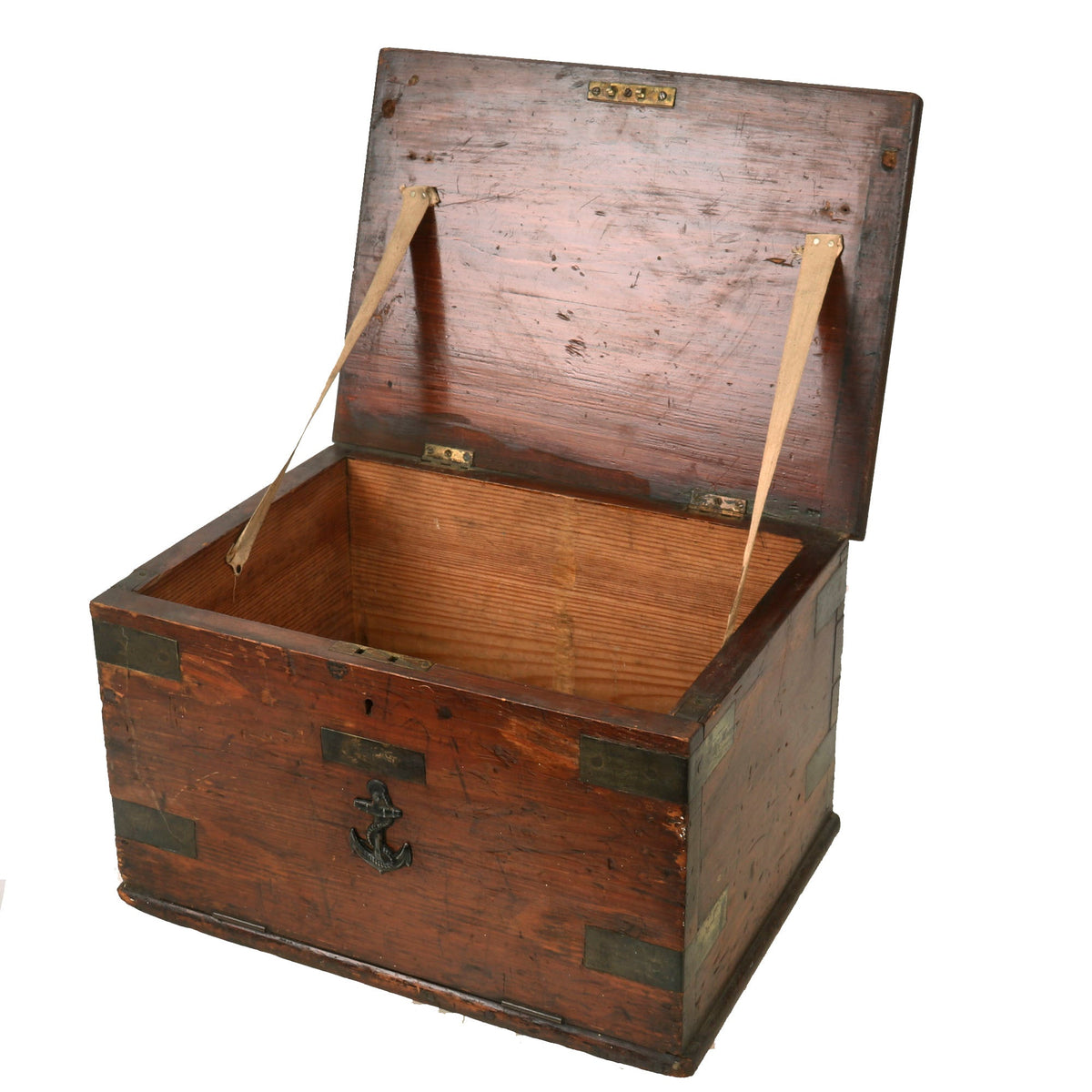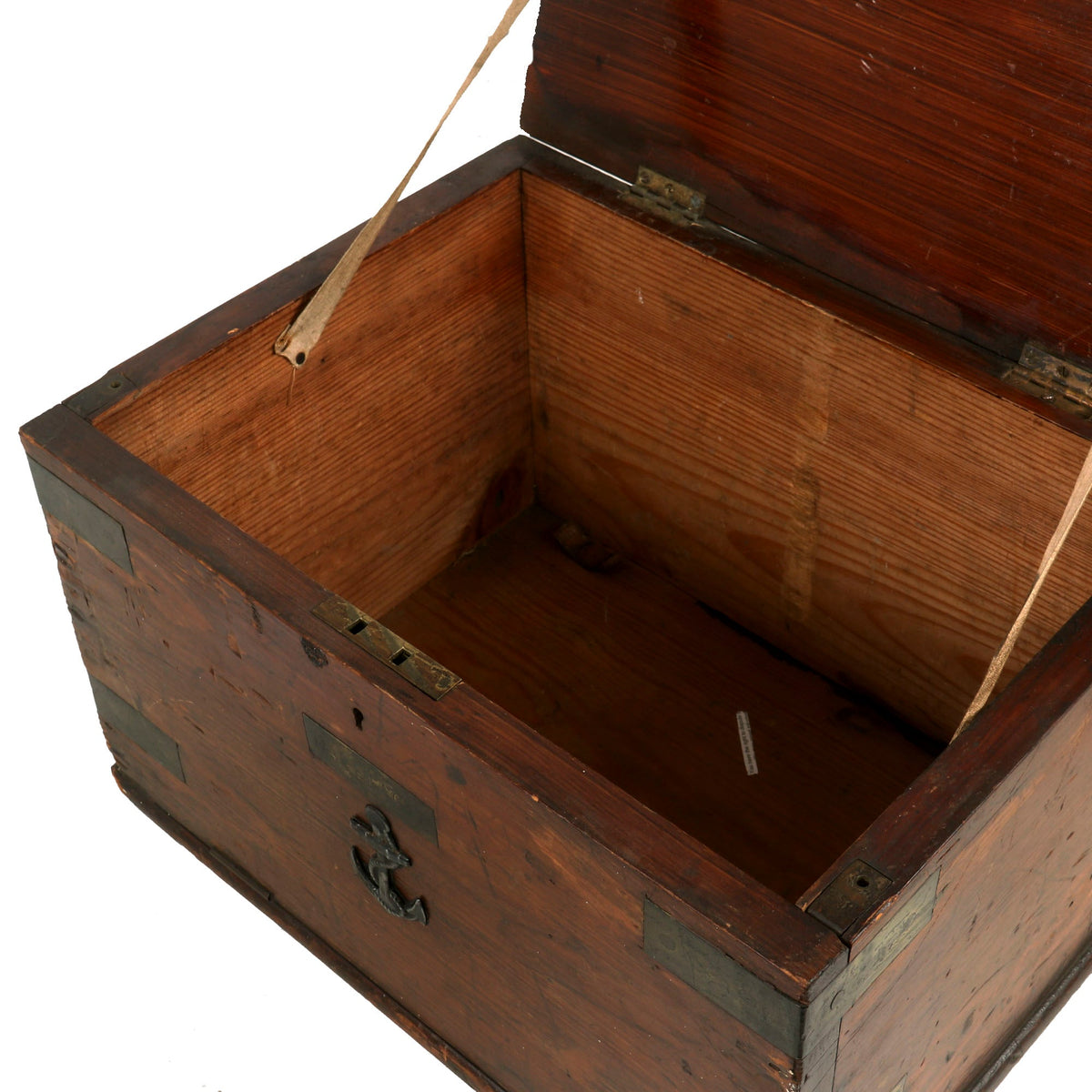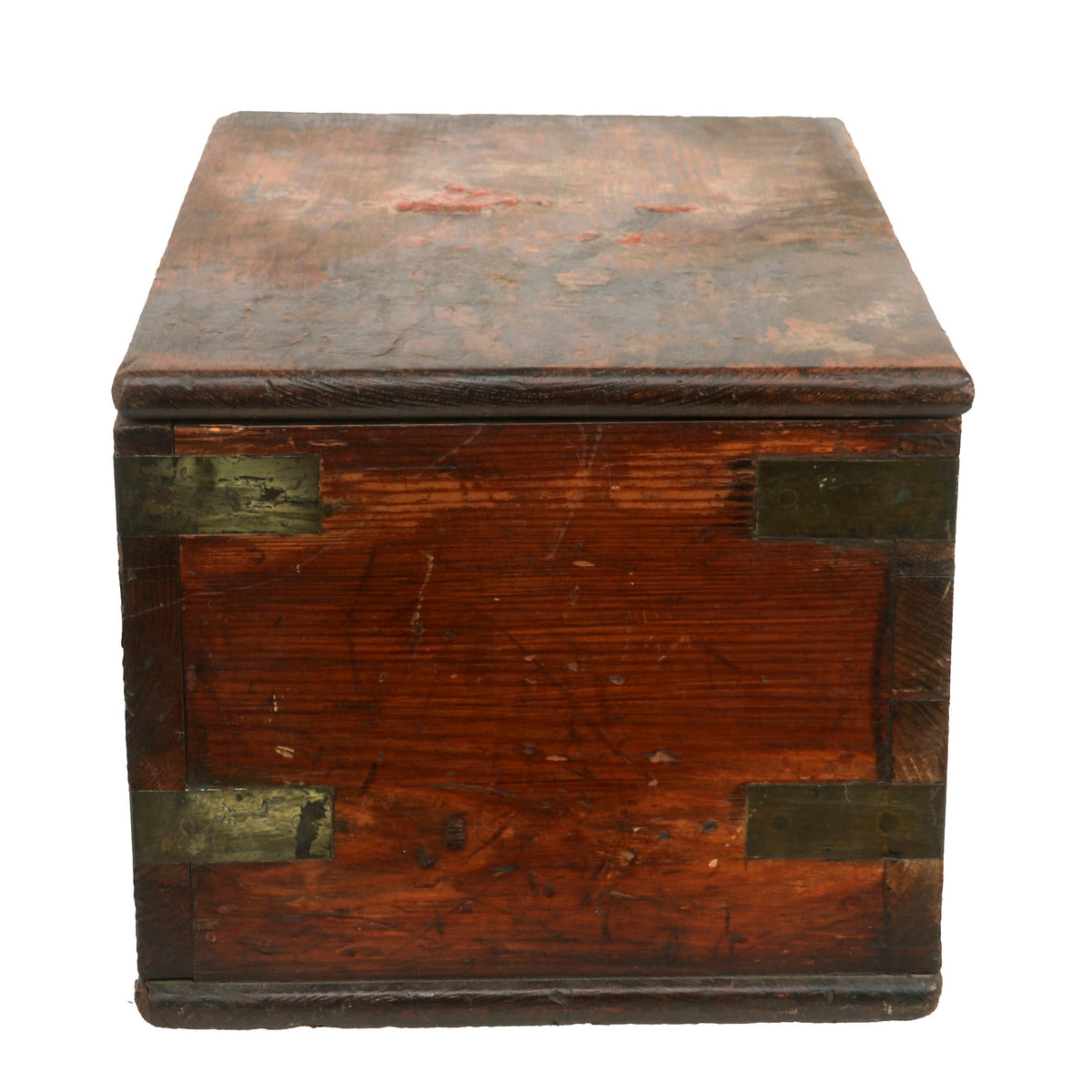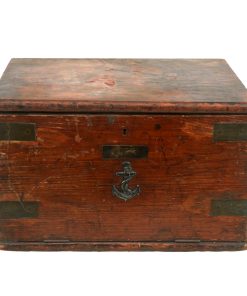Original British Napoleonic Wars Era Orders Chest of the HMS Eagle (1804) with Original Key Original Items
$ 1.395,00 $ 348,75
Original Item: Only One Available. This British orders chest was obtained from a private collection of Napoleonic era naval equipment. The chest is strongly constructed of wood and brass and measures 15.6 inches (39.7 cm) wide, 11.5 inches (29 cm) deep, and 9.6 inches (24.5 cm) high. At some point in its history, it looks like an inkbottle was tipped over and blackened some of the lid and the back. Old sealing wax is spotted around the lid and back, also, testifying graphically to the chest’s original function.
An orders chest was a necessary item of equipment on every warship, as it was a common practice – in fact, it still is – for a commander to receive sealed orders to be opened only when the ship was at sea. The orders chest was the secure storage for such sailing orders.
Two brass corner braces bind each of the four corners, beautifully inlet into the wood. This would be overkill for such a chest used on land, but considering the violent motions of a wooden sailing ship, such stout construction would be a necessity. An additional provision for rough usage was a pair of brass studs placed along the top edge of the box to keep the lid aligned when it is closed. The studs project into recesses in the underside of the lid. One of these studs is still present, while one is missing.
The front of the chest is decorated with a 2.5-inch (6.4 cm) brass anchor entwined with its cable. Above the anchor is a small brass plate engraved HMS EAGLE. Directly above this is the lock for the lid. Amazingly, the key is still present. One feature of the chest that remains a mystery is the presence of two inset hinges between the bottom plate and the front panel. At this time, the bottom is securely screwed to the four sides, but perhaps this was not always so.
The ship from which this chest came, HMS Eagle, had an illustrious and exciting career. A description of its exploits reads like one of Patrick O’Brian’s sea novels about Captain Jack Aubrey, such as Master and Commander. The Eagle was completed in 1804 while the Napoleonic wars were raging throughout Europe and the Mediterranean. We’ve provided below a link to one of the Web sites that tells the Eagle’s story, but here is a sample:
Following information that the enemy was sending three vessels, loaded with powder, along the coast of Istria, EAGLE and ELIZABETH went in search of them. On 8 June they were found at Omago and the marines from the two ships first drove about 100 soldiers out of the town before the seamen under Lieuts. GREENAWAY and HOTHAM of EAGLE and ROBERTS and BENNETT of ELIZABETH destroyed a 2-gun battery and brought off two boats laden with wine.
How can one not love such a tale? Three officers and a bunch of Royal Marines set out to capture three ships carrying gunpowder and instead come back with two ships loaded with wine! They certainly had their priorities straight.
The Eagle went on to have an extraordinarily long career after the Napoleonic Wars were over, continuing in service until 1926, when a fire destroyed her. Altogether, she served for 122 years.
This link is to the HMS Eagle page of Michael Phillips Ships of the Old Navy:
http:///MichaelPhillips/info.php?ref=0796
This is an extraordinary piece of British naval history, still in phenomenal condition after so many years. It will become the centerpiece of any early British naval collection. Comes ready for further research and display!
Fast Shipping with Professional Packaging
Thanks to our longstanding association with UPS FedEx DHL, and other major international carriers, we are able to provide a range of shipping options. Our warehouse staff is expertly trained and will wrap your products according to our exact and precise specifications. Prior to shipping, your goods will be thoroughly examined and securely secured. We ship to thousands clients each day across multiple countries. This shows how we're dedicated to be the largest retailer on the internet. Warehouses and distribution centres can be located throughout Europe as well as the USA.
Note: Orders with more than one item will be assigned a processing date depending on the item.
Before shipping before shipping, we'll conduct a thorough inspection of the items you have ordered. Today, the majority of orders will be delivered within 48 hours. The delivery time will be between 3-7 days.
Returns
The stock is dynamic and we cannot completely manage it because multiple stakeholders are involved, including our factory and warehouse. So the actual stock may alter at any time. It's possible that you may not receive your order once the order has been made.
Our policy is valid for a period of 30 days. If you don't receive the product within 30 days, we are not able to issue a refund or an exchange.
You can only return an item if it is unused and in the same state as the day you received it. You must have the item in its original packaging.
Related products
Uncategorized
Uncategorized
Uncategorized
Uncategorized
Uncategorized
Uncategorized
Armored Burgonet Helmet & Polearm from Scottish Castle Leith Hall Circa 1700 Original Items
Uncategorized
Uncategorized
Uncategorized
Uncategorized
Uncategorized
Uncategorized
Uncategorized
Uncategorized
Uncategorized
Band of Brothers ORIGINAL GERMAN WWII Le. F.H. 18 10.5cm ARTILLERY PIECE Original Items
Uncategorized
Angolan Rebel 1970s era 60mm Inert Display Mortar from Angolan Civil War Original Items
Uncategorized
Uncategorized
Armoured Fighting Vehicles of the World: AFVs of World War One (Hardcover Book) New Made Items
Uncategorized
Uncategorized

